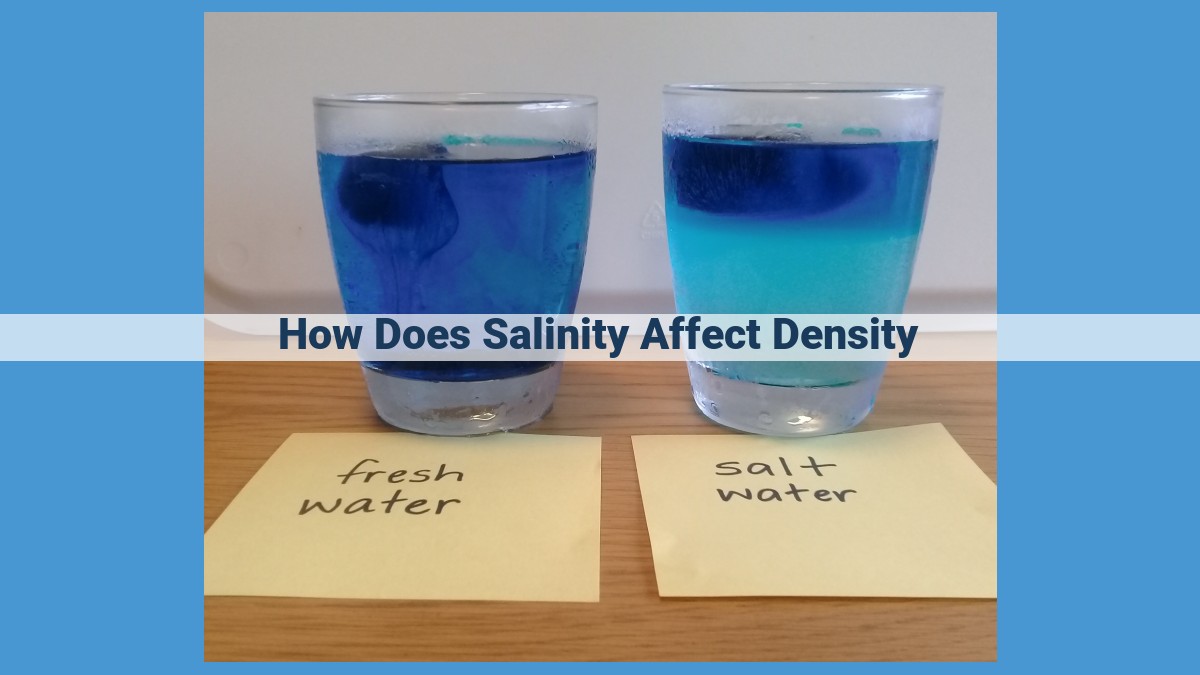Salinity, the dissolved salt content in water, significantly affects its density. Dissolved salts increase mass without significantly altering volume, resulting in water with higher salinity being denser. This relationship is crucial in oceanography, where salinity-density data helps understand ocean currents and water masses. In marine navigation, it aids in determining ship buoyancy and navigation. Additionally, in oil and gas exploration, salinity-density measurements assist in locating and evaluating hydrocarbon reservoirs.
Understanding Salinity: A Key Oceanographic Parameter
In the vast expanse of our oceans, salinity plays a pivotal role in shaping the marine environment and influencing countless biological and physical processes. Defined as the measure of dissolved salts in a water body, salinity holds immense importance for oceanographers seeking to unravel the intricacies of our aquatic ecosystems.
What is Salinity?
Salinity encompasses all the dissolved inorganic salts, primarily sodium, chloride, magnesium, and calcium, found within seawater. These salts originate from various sources, including weathering of rocks on land, hydrothermal vents, and volcanic eruptions. Salinity serves as a vital water characteristic in oceanography, providing insights into the physical and chemical dynamics of marine systems.
Measuring Salinity: The Practical Salinity Scale
Measuring salinity accurately is paramount to understanding its influence on oceanographic processes. The Practical Salinity Scale (PSS) is the accepted standard for quantifying salinity. It defines salinity in terms of electrical conductivity, which is directly proportional to the concentration of dissolved salts. Salinity is typically expressed in parts per thousand (ppt), where 1 ppt corresponds to 1 gram of salt dissolved in 1 kilogram of seawater. The average salinity of the global ocean is approximately 35 ppt, although it can vary widely depending on location and depth.
Factors Influencing Salinity: The Dance of Evaporation, Precipitation, and Discharge
Salinity, the dissolved salt content of water, is a crucial factor in oceanography, shaping the behavior of water bodies and influencing marine life. Understanding the factors that influence salinity is essential for unraveling the intricate tapestry of our oceans.
Evaporation: Leaving Behind Salty Traces
Imagine a vast expanse of ocean water shimmering under the relentless rays of the sun. As water evaporates, it carries with it pure H2O molecules, leaving behind the dissolved salts. These salts, primarily composed of sodium and chloride ions, accumulate over time, increasing the salinity of the remaining water.
Precipitation: Diluting the Salty Waters
In contrast to evaporation, precipitation has a diluting effect on salinity. Raindrops, formed from water vapor in the atmosphere, are devoid of salts. When rain falls into the ocean, it introduces freshwater, diluting the concentrated salt content.
River Discharge: A Freshwater Tributary
Rivers, meandering through land, collect freshwater from rain, snowmelt, and groundwater. As they converge with the ocean, river discharge introduces a significant volume of freshwater into the marine environment. This influx of freshwater helps lower salinity, particularly in coastal regions near river mouths.
Salinity and Its Impact on Water Density
Understanding the Salinity-Density Enigma
In the realm of aquatic ecosystems, salinity reigns supreme as a pivotal factor influencing water’s behavior. Salinity, simply put, refers to the amount of dissolved salts in a given volume of water. It exerts a profound effect on water’s density, a measure of its mass per unit volume.
The Interplay Between Dissolved Salts and Density
The presence of dissolved salts is directly correlated with water density. When salts are dissolved in water, they dissociate into ions, which contribute to the water’s mass without significantly increasing its volume. This mass-without-volume phenomenon results in a higher density for the saltwater solution compared to pure water.
Density and Its Practical Implications
The salinity-density relationship has far-reaching consequences in various fields. In oceanography, it aids in understanding the formation of ocean currents and the distribution of water masses. In marine navigation, it influences ship buoyancy and affects routes and fuel consumption. Additionally, in oil and gas exploration, salinity-density data helps locate and characterize hydrocarbon reservoirs.
The Dance of Salinity and Density
To illustrate the effects of salinity on density, consider the Dead Sea, known for its exceptionally high salt content. The Dead Sea’s salinity is approximately 34%, or 34 parts of dissolved salts per 1000 parts of water. This high salinity makes it one of the densest bodies of water on Earth, allowing objects to float effortlessly on its surface.
Conversely, the Amazon River, with its vast freshwater discharge, possesses a low salinity and, as a result, a lower density. This freshwater influx from rivers helps dilute the salt content and reduce the overall density of ocean water near river mouths.
The salinity-density relationship is a fundamental principle that governs the behavior of water in marine and aquatic environments. Its influence extends from shaping ocean currents to affecting marine navigation and even guiding oil and gas exploration. Understanding this relationship is crucial for deciphering the mysteries of the aquatic world.
Practical Applications of Salinity-Density Relationship
Salinity and density, intertwined like the ocean’s tides, hold profound importance in various fields. Let’s dive into how this relationship unveils hidden secrets in the watery depths.
Oceanography: Navigating the Secrets of the Sea
Oceanographers rely on salinity-density data to study the Earth’s ocean currents. By measuring density variations, they can identify boundaries between different water masses, revealing the intricate dance of warm and cold currents. These currents influence marine ecosystems and drive global climate patterns.
Marine Navigation: Ensuring Safe Sailing
For mariners, salinity-density measurements are crucial for ship buoyancy. Ships float higher in less dense water, while they sink deeper in denser water. By monitoring salinity, navigators can ensure their vessels maintain optimal buoyancy, preventing dangerous incidents.
Oil and Gas Exploration: Uncovering Hidden Treasures
In the realm of oil and gas exploration, salinity-density measurements play a vital role in locating and characterizing hydrocarbon reservoirs. Denser fluids, including oil and gas, tend to accumulate in less dense formations. By analyzing salinity-density profiles, geologists can pinpoint potential hydrocarbon traps. This invaluable information guides drilling operations, maximizing the extraction of Earth’s energy resources.
